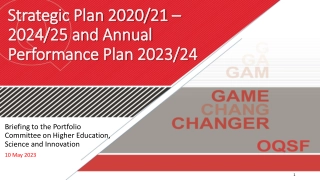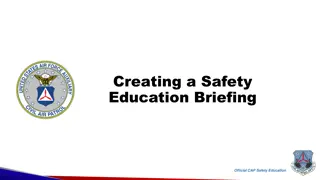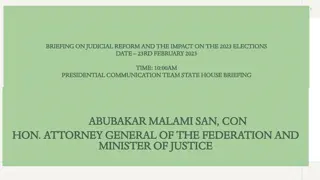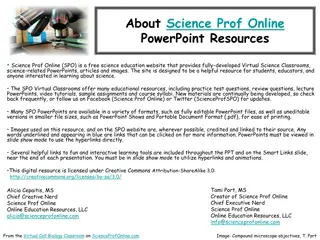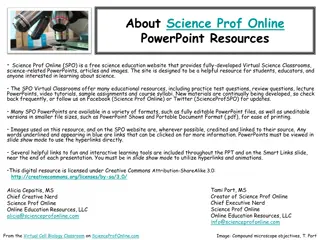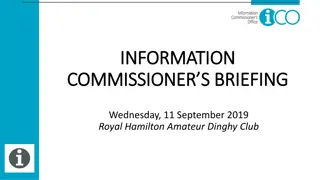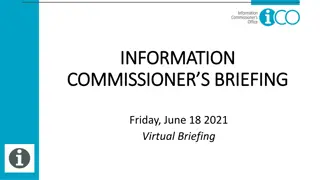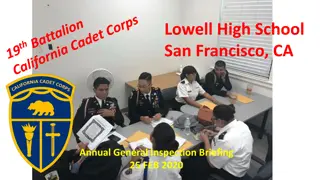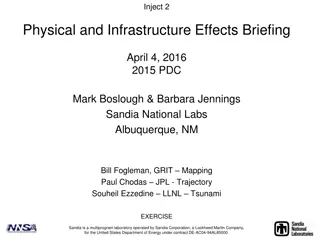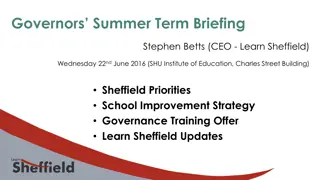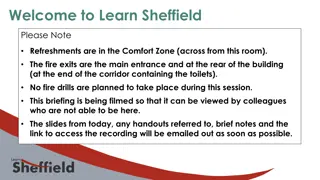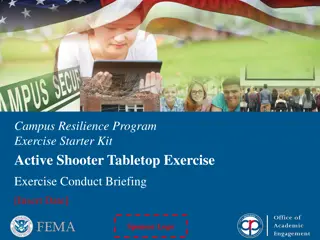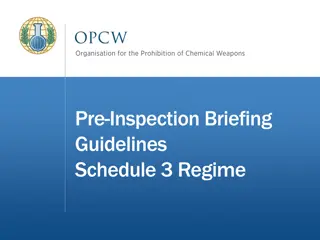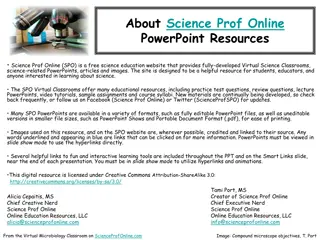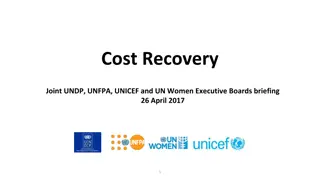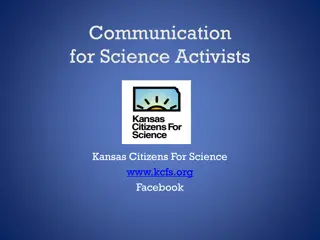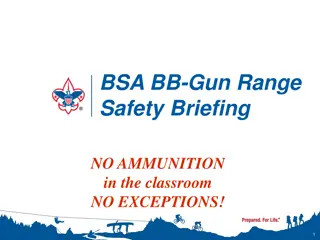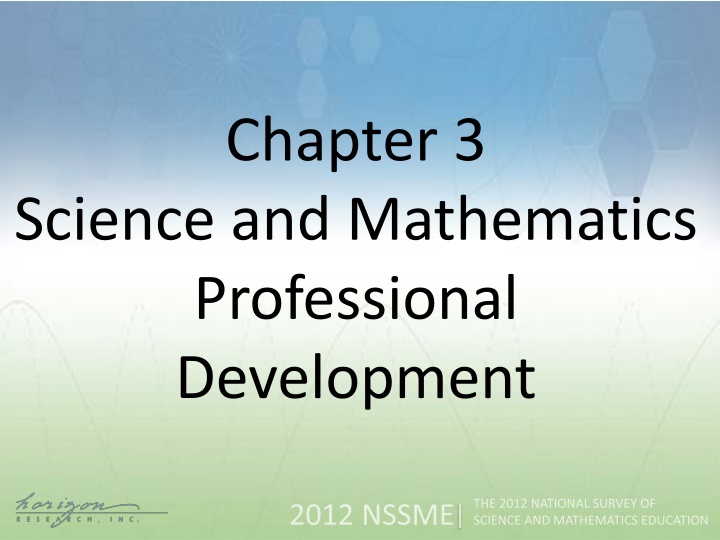
Professional Development Insights for Science and Mathematics Educators
Explore data on science and math professional development for educators, including participation rates, time spent, and activities attended over the last three years. Gain valuable insights into the engagement of teachers at different grade levels in enhancing their professional skills and knowledge in STEM fields.
Download Presentation

Please find below an Image/Link to download the presentation.
The content on the website is provided AS IS for your information and personal use only. It may not be sold, licensed, or shared on other websites without obtaining consent from the author. If you encounter any issues during the download, it is possible that the publisher has removed the file from their server.
You are allowed to download the files provided on this website for personal or commercial use, subject to the condition that they are used lawfully. All files are the property of their respective owners.
The content on the website is provided AS IS for your information and personal use only. It may not be sold, licensed, or shared on other websites without obtaining consent from the author.
E N D
Presentation Transcript
Chapter 3 Science and Mathematics Professional Development
Teacher Professional Development
Original Data for Slide 5 (not for presentation) Table 3.1 Science Teachers Most Recent Participation in Science-Focused Professional Development, by Grade Range Percent of Teachers Middle 82 6 3 4 6 In the last 3 years 4 6 years ago 7 10 years ago More than 10 years ago Never Includes professional development focused on science or science teaching. Elementary 59 16 5 5 15 High 85 7 2 1 5 (2.0) (1.4) (0.8) (0.8) (1.4) (2.3) (1.2) (1.0) (1.3) (1.4) (1.3) (0.7) (0.3) (0.4) (1.0)
Science Teachers Participating in Science-Focused PD in the Last 3 Years, by Grade Range 100 85 82 80 Percent of Teachers 59 60 40 20 0 Elementary Middle High
Original Data for Slide 7 (not for presentation) Table 3.3 Time Spent on Professional Development in the Last Three Years, by Subject and Grade Range Percent of Teachers Middle 30 24 20 27 Science Less than 6 hours 6 15 hours 16 35 hours More than 35 hours Elementary 65 22 8 4 High 23 20 21 36 (1.9) (1.7) (0.9) (0.7) (2.6) (1.8) (2.0) (2.0) (1.6) (1.1) (1.4) (1.1)
Science Teachers Time Spent on Science- Focused PD in Last 3 years, by Grade Range 80 65 Percent of Teachers 60 36 40 30 27 24 23 22 21 20 20 20 8 4 0 Elementary Middle High <6 hours 6 15 hours 16 35 hours >35 hours
Original Data for Slides 911 (not for presentation) Table 3.5 Science Teachers Participating in Various Professional Development Activities in the Last Three Years, by Grade Range Attended a workshop on science or science teaching Participated in a professional learning community/lesson study/teacher study group focused on science or science teaching Received feedback about your science teaching from a mentor/coach formally assigned by the school/district/diocese Attended a national, state, or regional science teacher association meeting This item was asked of all teachers whether or not they had participated in professional development in the last three years. Percent of Teachers Middle (1.8) 91 Elementary 84 High 90 (1.7) (1.2) 55 (2.4) 75 (2.5) 73 (1.6) 24 (2.5) 47 (3.5) 54 (2.4) 8 (1.2) 35 (2.8) 44 (1.7)
Elementary School Science Teachers Participating in Various PD Activities in the Last 3 Years Attended a workshop on science/science teaching 84 Participated in PD study group 55 Received feedback about science teaching from mentor/coach 24 Attended national, state, regional science teacher association meeting 8 0 20 40 60 80 100 Percent of Teachers
Middle School Science Teachers Participating in Various PD Activities in the Last 3 Years Attended a workshop on science/science teaching 91 Participated in PD study group 75 Received feedback about science teaching from mentor/coach 47 Attended national, state, regional science teacher association meeting 35 0 20 40 60 80 100 Percent of Teachers
High School Science Teachers Participating in Various PD Activities in the Last 3 Years Attended a workshop on science/science teaching 90 Participated in PD study group 73 Received feedback about science teaching from mentor/coach 54 Attended national, state, regional science teacher association meeting 44 0 20 40 60 80 100 Percent of Teachers
Original Data for Slides 1315 (not for presentation) Table 3.7 Science Teachers Whose Professional Development in the Last Three Years Had Each of a Number of Characteristics to a Substantial Extent, by Grade Range Worked closely with other science teachers from your school Worked closely with other science teachers who taught the same grade and/or subject whether or not they were from your school Had opportunities to try out what you learned in your classroom and then talk about it as part of the professional development Had opportunities to engage in science investigations Had opportunities to examine classroom artifacts (e.g., student work samples) The professional development was a waste of time Includes teachers indicating 4 or 5 on a 5-point scale ranging from 1 Not at all to 5 To a great extent. Percent of Teachers Middle (3.5) 61 Elementary 34 High 62 (3.5) (2.6) 37 (3.4) 54 (4.0) 58 (2.6) 34 48 (3.3) (3.5) 51 52 (4.5) (3.0) 47 45 (2.4) (2.8) 31 8 (3.5) (2.0) 40 5 (3.4) (1.1) 33 8 (2.4) (1.1)
Elementary School Science Teachers Whose PD in the Last 3 Years Had Various Characteristics to a Substantial Extent Had opportunities to engage in science investigations 48 Worked with teachers of same grade/subject whether or not from same school 37 Had opportunities to try new things in classroom, then discuss in PD 34 Worked with teachers from same school 34 Had opportunities to examine classroom artifacts 31 The PD was a waste of time 8 0 20 40 60 80 100 Percent of Teachers
Middle School Science Teachers Whose PD in the Last 3 Years Had Various Characteristics to a Substantial Extent Worked with teachers from same school 61 Worked with teachers of same grade/subject whether or not from same school 54 Had opportunities to engage in science investigations 52 Had opportunities to try new things in classroom, then discuss in PD 51 Had opportunities to examine classroom artifacts 40 The PD was a waste of time 5 0 20 40 60 80 100 Percent of Teachers
High School Science Teachers Whose PD in the Last 3 Years Had Various Characteristics to a Substantial Extent Worked with teachers from same school 62 Worked with teachers of same grade/subject whether or not from same school 58 Had opportunities to try new things in classroom, then discuss in PD 47 Had opportunities to engage in science investigations 45 Had opportunities to examine classroom artifacts 33 The PD was a waste of time 8 0 20 40 60 80 100 Percent of Teachers
Original Data for Slide 17 (not for presentation) Table 3.11 Science Teachers Most Recent College Coursework in Field, by Grade Range Percent of Teachers Middle (0.9) 22 (1.6) 14 (1.4) 19 (2.0) 44 (0.3) 1 (1.1) 21 (1.5) 14 (1.4) 16 (1.9) 38 (1.1) 11 (1.2) 27 (1.5) 16 (1.4) 17 (2.0) 39 (0.3) 1 Science In the last 3 years 4 6 years ago 7 10 years ago More than 10 years ago Never The Teaching of Science In the last 3 years 4 6 years ago 7 10 years ago More than 10 years ago Never Science or the Teaching of Science In the last 3 years 4 6 years ago 7 10 years ago More than 10 years ago Never Elementary 8 17 17 57 1 11 15 14 49 11 12 19 16 52 1 High 24 19 18 38 1 25 16 14 29 16 33 19 16 31 1 (2.4) (1.4) (2.1) (2.7) (0.5) (2.1) (1.3) (1.8) (2.6) (1.7) (2.6) (1.5) (2.0) (2.8) (0.5) (1.2) (1.1) (1.2) (1.2) (0.5) (1.4) (1.1) (1.1) (1.2) (1.4) (1.4) (1.0) (1.1) (1.2) (0.5)
Science Teachers Most Recent College Coursework in Field, by Grade Range 60 52 Percent of Teachers 39 40 33 31 27 19 19 17 20 16 16 16 12 1 1 1 0 Elementary Middle High In the last 3 years 4 6 years 7 10 years 10+ years Never
Original Data for Slides 1924 (not for presentation) Table 3.13 Science Teachers Reporting That Their Professional Development/Coursework in the Last Three Years Gave Heavy Emphasis to Various Areas, by Grade Range Percent of Teachers Middle Assessing student understanding at the conclusion of instruction on a topic Planning instruction so students at different levels of achievement can increase their understanding of the ideas targeted in each activity Monitoring student understanding during science instruction Learning about difficulties that students may have with particular science ideas and procedures Deepening their science content knowledge Finding out what students think or already know about the key science ideas prior to instruction on those ideas Providing enrichment experiences for gifted students Implementing the science textbook/module to be used in their classroom Providing alternative science learning experiences for students with special needs Teaching science to English-language learners Includes teachers responding 4 or 5 on a 5-point scale ranging from 1 Not at all to 5 To a great extent. Elementary High 47 (3.1) 54 (3.6) 58 (2.1) 47 45 (3.1) (3.0) 64 54 (3.5) (3.3) 56 55 (2.1) (2.2) 30 37 (2.6) (2.9) 42 51 (3.1) (4.0) 49 48 (2.5) (2.1) 41 32 (2.8) (2.7) 46 30 (3.8) (3.0) 44 33 (2.3) (2.2) 39 (3.5) 30 (2.9) 29 (1.7) 22 21 (2.5) (2.5) 26 18 (2.7) (2.4) 28 18 (2.1) (1.8)
Elementary School Science Teachers Reporting PD/Coursework in the Last 3 Years with Heavy Emphasis on Various Areas Planning instruction for students at different levels 47 Assessing student understanding 47 Monitoring student understanding 45 Finding out what students know prior to instruction 41 Implementing science textbook/module 39 0 20 40 60 80 100 Percent of Teachers
Elementary School Science Teachers Reporting PD/Coursework in the Last 3 Years with Heavy Emphasis on Various Areas Deepening their content knowledge 37 Providing enrichment for gifted students 32 Learning about student difficulties 30 Providing alternative learning experiences 22 Teaching content to ELLs 21 0 20 40 60 80 100 Percent of Teachers
Middle School Science Teachers Reporting PD/Coursework in the Last 3 Years with Heavy Emphasis on Various Areas Planning instruction for students at different levels 64 Monitoring student understanding 54 Assessing student understanding 54 Deepening their content knowledge 51 Finding out what students know prior to instruction 46 0 20 40 60 80 100 Percent of Teachers
Middle School Science Teachers Reporting PD/Coursework in the Last 3 Years with Heavy Emphasis on Various Areas Learning about student difficulties 42 Implementing science textbook/module 30 Providing enrichment for gifted students 30 Providing alternative learning experiences 26 Teaching content to ELLs 18 0 20 40 60 80 100 Percent of Teachers
High School Science Teachers Reporting PD/Coursework in the Last 3 Years with Heavy Emphasis on Various Areas 58 Assessing student understanding 56 Planning instruction for students at different levels 55 Monitoring student understanding 49 Learning about student difficulties 48 Deepening their content knowledge 0 20 40 60 80 100 Percent of Teachers
High School Science Teachers Reporting PD/Coursework in the Last 3 Years with Heavy Emphasis on Various Areas 44 Finding out what students know prior to instruction 33 Providing enrichment for gifted students 29 Implementing science textbook/module 28 Providing alternative learning experiences 18 Teaching content to ELLs 0 20 40 60 80 100 Percent of Teachers
Original Data for Slide 26 (not for presentation) Table 3.17 Science Teachers Serving in Various Leadership Roles in the Last Three Years, by Grade Range Percent of Teachers Middle (1.0) 19 (1.0) 17 (2.5) 24 (0.9) 15 Elementary 4 5 38 3 High 26 24 23 17 Led a teacher study group focused on science teaching Served as a formally assigned mentor/coach for science teaching Supervised a student teacher Taught in-service workshops on science or science teaching (2.5) (2.2) (2.5) (2.1) (2.1) (2.2) (1.7) (1.9)
Science Teachers Serving in Various Leadership Roles in Last 3 Years, by Grade Range 100 80 Percent of Teachers 60 38 40 26 24 24 23 19 17 17 15 20 5 4 3 0 Elementary Middle High Led teacher study group Served as formal mentor/coach Supervised student teacher Taught in-service workshops
Professional Development Offerings at the School Level
Original Data for Slide 29 (not for presentation) Table 3.19 Professional Development Workshops Offered Locally in the Last Three Years, by Subject and Grade Range Percent of Schools Science 48 42 36 Elementary Middle High (2.9) (3.6) (4.0)
Science PD Workshops Offered Locally in the Last 3 Years, by Grade Range 100 80 Percent of Schools 60 48 42 36 40 20 0 Elementary Middle High
Original Data for Slides 3132 (not for presentation) Table 3.20 Locally Offered Professional Development Workshops in the Last Three Years with a Substantial Focus in Each of a Number of Areas, by Subject Percent of Schools Science 64 52 52 41 33 31 31 51 11 18 State science/mathematics standards Science/mathematics content How to use particular science/mathematics instructional materials How to use technology in science/mathematics instruction How to monitor student understanding during science/mathematics instruction How students think about various science/mathematics ideas How to adapt science/mathematics instruction to address student misconceptions How to use investigation-oriented science/mathematics teaching strategies How to provide alternative science/mathematics learning experiences for students with special needs How to teach science/mathematics to students who are English language learners Includes schools where respondent indicated 4 or 5 on a 5-point scale ranging from 1 Not at all to 5 To a great extent. (2.9) (3.2) (3.1) (2.9) (2.6) (2.4) (2.7) (3.2) (1.7) (2.5)
Locally Offered Science PD Workshops in the Last 3 Years with Substantial Focus in Various Areas State science standards 64 How to use instructional materials 52 Science content 52 How to use investigation teaching strategies 51 How to use technology 41 0 20 40 60 80 100 Percent of Schools
Locally Offered Science PD Workshops in the Last 3 Years with Substantial Focus in Various Areas How to monitor student understanding 33 How to adapt instruction to address misconceptions 31 How students think about science ideas 31 How to teach science to ELL students 18 How to provide learning experiences for special needs students 11 0 20 40 60 80 100 Percent of Schools
Original Data for Slide 34 (not for presentation) Table 3.21 Teacher Study Groups Offered at Schools in the Last Three Years, by Subject and Grade Range Percent of Schools Science 32 43 47 Elementary Middle High (3.0) (3.7) (4.4)
Science Teacher Study Groups Offered at Schools in the Last 3 Years, by Grade Range 100 80 Percent of Schools 60 47 43 40 32 20 0 Elementary Middle High
Original Data for Slide 36 (not for presentation) Table 3.22 Characteristics of Teacher Study Groups, by Subject Percent of Schools Science 79 62 56 Participation is required School specifies schedule Has designated leaders Includes only those schools that offered teacher study groups in the last three years. (2.5) (2.9) (3.3)
Characteristics of Science Teacher Study Groups 100 79 80 Percent of Schools 62 56 60 40 20 0 Participation is required School specifies schedule Has designated leaders
Original Data for Slide 38 (not for presentation) Table 3.23 Origin of Designated Leaders of Teacher Study Groups, by Subject From within the school From another school in district/diocese From external sources Includes only those schools that offered teacher study groups in the last three years with designated leaders. Item presented only to public and Catholic schools. Percent of Schools Science 87 26 13 (3.0) (3.2) (3.0)
Origin of Designated Leaders of Science Teacher Study Groups 100 87 80 Percent of Schools 60 40 26 20 13 0 From within the school From another school in district/diocese From external sources
Original Data for Slides 4041 (not for presentation) Table 3.24 Frequency and Duration of Teacher Study Groups, by Subject Percent of Schools Science 25 31 12 31 89 7 4 Frequency Less than once a month Once a month Twice a month More than twice a month Duration The entire school year One semester Less than one semester Includes only those schools that offered teacher study groups in the last three years with specified schedules. (4.0) (3.6) (1.9) (3.5) (2.3) (1.9) (1.2)
Frequency of Science Teacher Study Groups 40 31 31 Percent of Schools 25 20 12 0 Less than once a month Once a month Twice a month More than twice a month
Duration of Science Teacher Study Groups 100 89 80 Percent of Schools 60 40 20 7 4 0 The entire school year One semester Less than one semester
Original Data for Slide 43 (not for presentation) Table 3.25 Composition of Teacher Study Groups, by Subject Limited to teachers from this school Include teachers from other schools in the district/diocese Include teachers from other schools outside of their jurisdiction Include teachers from multiple grade levels Include school and/or district/diocese administrators Include higher education faculty or other consultants Include parents/guardians or other community members Includes only those schools that offered teacher study groups in the last three years. Item presented only to public and Catholic schools. Percent of Schools Science 66 35 7 65 44 10 0 (3.9) (3.8) (3.0) (3.4) (3.7) (2.4) (0.1)
Composition of Science Teacher Study Groups 66 Teachers from this school 65 Teachers from multiple grade levels 44 School and/or district/diocese administrators 35 Teachers from other schools in district/diocese 7 Teachers from other schools outside jurisdiction 10 Higher education faculty 0 Parent/guardians or other community members 0 20 40 60 80 100 Percent of Schools
Original Data for Slide 45 (not for presentation) Table 3.26 Description of Activities in Typical Teacher Study Groups, by Subject Teachers analyze student science/mathematics assessment results Teachers analyze science/mathematics instructional materials Teachers plan science/mathematics lessons together Teachers analyze classroom artifacts Teachers engage in science/mathematics investigations Includes only those schools that offered teacher study groups in the last three years. Percent of Schools Science 73 65 67 37 25 (3.5) (3.3) (3.0) (3.6) (2.9)
Description of Activities in Typical Science Teacher Study Groups Analyze student assessment results 73 Plan lessons together 67 Analyze instructional materials 65 Analyze classroom artifacts 37 Engage in investigations 25 0 20 40 60 80 100 Percent of Schools
Original Data for Slide 47 (not for presentation) Table 3.27 How Schools Provide Time for Science/Mathematics Professional Development Professional days/teacher work days during the students school year Common planning time for teachers Professional days/teacher work days before and/or after the students school year Substitute teachers to cover teachers classes while they attend professional development Early dismissal and/or late start for students Includes in-service workshops and teacher study groups. Percent of Schools Science 55 41 38 36 29 (2.6) (2.6) (2.2) (2.8) (2.1)
How Schools Provide Time for Science PD Teacher work days during school year 55 Common planning time 41 Teacher work days before/after school year 38 Substitute teachers cover classes 36 Early dismissal/Late start 29 0 20 40 60 80 100 Percent of Schools
Original Data for Slide 49 (not for presentation) Table 3.28 Schools Providing One-on-One Science/Mathematics Coaching Elementary Middle High Percent of Schools Science 17 17 22 (1.9) (2.1) (2.0)
Schools Providing One-on-One Science Coaching 100 80 Percent of Schools 60 40 22 17 17 20 0 Elementary Middle High
Original Data for Slide 51 (not for presentation) Table 3.29 Teaching Professionals Providing Science- and Mathematics-Focused One-on-One Coaching Percent of Schools Science 64 25 12 Both teachers/coaches and administrators Teachers/coaches only Administrators only Includes only those schools that provide science/mathematics-focused coaching. Includes teachers/coaches of all levels of teaching responsibility: full-time, part-time, and not teaching. (4.0) (3.5) (3.5)

